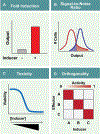Small molecule-inducible gene regulatory systems in mammalian cells: progress and design principles
- PMID: 36332343
- PMCID: PMC9951109
- DOI: 10.1016/j.copbio.2022.102823
Small molecule-inducible gene regulatory systems in mammalian cells: progress and design principles
Abstract
Small molecule-inducible gene circuits are some of the most important tools in biology because they provide a convenient way to exert precise regulation of biological systems. These systems typically are designed to govern gene activation, repression, or disruption at multiple levels, such as through genome modification, transcription, translation, or post-translational regulation of protein activity. Due to their importance, many new systems have been created in the past few years to address different needs or afford orthogonality. They can be broadly characterized based on the inducer used, the mode of regulation, and the effector protein enabling the regulation. Furthermore, each synthetic circuit has varying performance metrics and design considerations. Here, we provide a concise comparison of recently developed tools and recommend standardized metrics for evaluating their performance and potential as biological interrogators or therapeutics.
Copyright © 2022 Elsevier Ltd. All rights reserved.
Figures



References
-
-
Rauch S, Jones KA, and Dickinson BC, “Small Molecule-Inducible RNA-Targeting Systems for Temporal Control of RNA Regulation,” ACS Central Science, vol. 6, no. 11, pp. 1987–1996, Nov. 2020, doi: 10.1021/ACSCENTSCI.0C00537.
• This work describes an ABA-inducible RNA base editor biosensor platform that can perform RNA editing, degradation, or induced translation. Furthermore, they demonstrate this system in-vivo, expanding the toolbox for studying dynamic RNA regulation.
-
Publication types
MeSH terms
Substances
Grants and funding
LinkOut - more resources
Full Text Sources
Other Literature Sources
Miscellaneous

